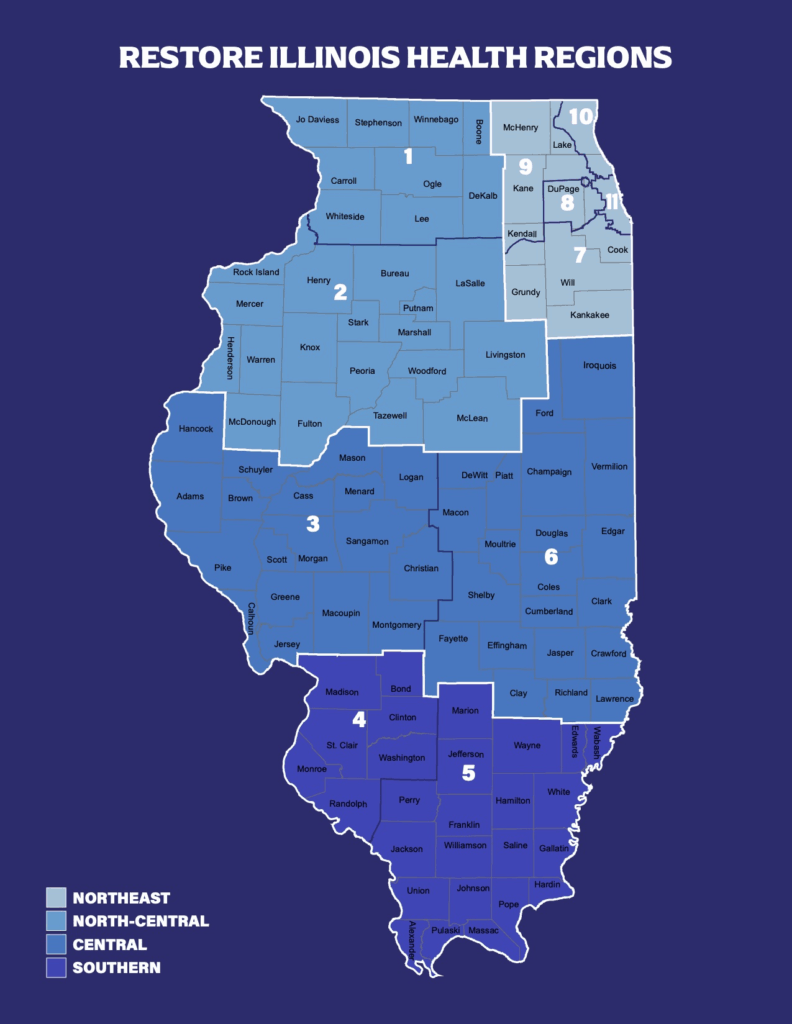Pritzker Announces Restore Illinois: A Public Health Approach To Safely Reopen Our State
|
|
Governor Pritzker Announces Restore Illinois: A Public Health Approach To Safely Reopen Our State
Restore Illinois is a Five-Phase, Regional Plan for Saving Lives, Livelihoods, and Safely Reopening Illinois
Chicago – Building on data, science, and guidance from public health experts and after consulting with stakeholders across the state, Governor JB Pritzker announced Restore Illinois, a five-phase plan focused on saving lives, livelihood, and safely reopening Illinois.
The five-phase plan is guided by public health metrics designed to provide a framework for reopening businesses, education, and recreational activities in each phase. This initial plan can and will be updated as research and science develop and as the potential for effective treatments or vaccines is realized.
The five-phase plan is based on regional healthcare availability and recognizes the distinct impact COVID-19 has had on different regions of our state as well as regional variations in hospital capacity. The Illinois Department of Public Health (IDPH) has 11 Emergency Medical Services Regions that have traditionally guided its statewide public health work. For the purposes of Restore Illinois, from those 11, four health regions are established, each with the ability to independently move through a phased approach: Northeast Illinois; North-Central Illinois; Central Illinois; and Southern Illinois.

The five phases of reopening for each health region are as follows:
Phase 1 – Rapid Spread: The rate of infection among those tested and the number of patients admitted to the hospital is high or rapidly increasing. Strict stay at home and social distancing guidelines are put in place and only essential businesses remain open. Every region has experienced this phase once already and could return to it if mitigation efforts are unsuccessful.
Phase 2 – Flattening: The rate of infection among those tested and the number of patients admitted to the hospital beds and ICU beds increases at an ever slower rate, moving toward a flat and even a downward trajectory. Non-essential retail stores reopen for curb-side pickup and delivery. Illinoisans are directed to wear a face covering when outside the home, and can begin enjoying additional outdoor activities like golf, boating and fishing while practicing social distancing. To varying degrees, every region is experiencing flattening as of early May.
Phase 3 – Recovery: The rate of infection among those tested, the number of patients admitted to the hospital, and the number of patients needing ICU beds is stable or declining. Manufacturing, offices, retail, barbershops and salons can reopen to the public with capacity and other limits and safety precautions. All gatherings limited to 10 or fewer people are allowed. Face coverings and social distancing are the norm.
Phase 4 – Revitalization: The rate of infection among those tested and the number of patients admitted to the hospital continues to decline. All gatherings of up to 50 people are allowed, restaurants and bars reopen, travel resumes, child care and schools reopen under guidance from the IDPH. Face coverings and social distancing are the norm.
Phase 5 – Illinois Restored: With a vaccine or highly effective treatment widely available or the elimination of any new cases over a sustained period, the economy fully reopens with safety precautions continuing. Conventions, festivals and large events are permitted, and all businesses, schools, and places of recreation can open with new safety guidance and procedures in place reflecting the lessons learned during the COVID-19 pandemic.

Until COVID-19 is defeated, Restore Illinois recognizes that as health metrics tell us it is safe to move forward, health metrics may also tell us to return to a prior phase. With a vaccine or treatment not yet available, IDPH will be closely monitoring key metrics to immediately identify new growth in cases and hospitalizations to determine whether a return to a prior phase is needed.
As millions of Illinoisans continue working together by staying at home and following experts’ recommendations, the result has been a lower infection rate, lower hospitalizations, and lower number of fatalities than without these measures. As the state’s curve begins to flatten, the risk of spread remains, and modeling and data point to a rapid surge in new cases if all mitigation measures are immediately lifted. The governor and his administration continue to urge all Illinois residents to follow the state’s stay at home order and to follow the guidance issued by the state and public health experts.
Resources:

